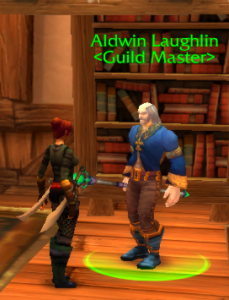
With Wrath of the Lich King on the horizon, quite a few ambitious players will be looking for new and better guilds. An expansion is a logical time for a guild roster shakeup, and the enterprising raider knows that the best time to look for a new guild is right now. For an excellent guide to finding a new raiding guild, see Bellwether’s four-part series on the topic.
 This series of posts has a different purpose. In this multipart series, I will show prospective Guild Masters how to build a new organization from zero. Installments in the series will come out twice every week, on Wednesdays and Fridays. Read on to find out how can you take a bunch of n00bs who don’t know jack about being in a raiding guild and turn them into a well-oiled tier gear-acquiring machine.
This series of posts has a different purpose. In this multipart series, I will show prospective Guild Masters how to build a new organization from zero. Installments in the series will come out twice every week, on Wednesdays and Fridays. Read on to find out how can you take a bunch of n00bs who don’t know jack about being in a raiding guild and turn them into a well-oiled tier gear-acquiring machine.
Wait, do I really want to be a Guild Master?
Before I tell you how to go about building the guild of your dreams, there are questions that you, the prospective GM, must ask yourself.
1. What kind of guild do I want to be in?
Now is the time for soul-searching. For me, the answer was easy. I wanted to be in a guild that was kind, respectful, helpful, and, at the same time, extremely good at raiding. My personal criteria for the perfect guild were unusual–I wanted a bona fide raiding guild, but I also wanted a supportive environment to learn in. I wasn’t good enough to join one of the top guilds on the server, so I also needed a place that would take someone whose skills hadn’t fully developed yet. The best answer, for me, was to join with others in forming a new guild.
Think about your own wants and needs. How much do you play? What kind of hours do you want to put in raiding? How much say do you want to have in guild decisions? What kind of attitude do you want your guild to have? When you’re designing from zero, you can control all of these factors.
2. How much work can I put in?
If you’re going to be a GM, or even an officer, you need to have free time that you’re willing to dedicate to the daily business of running a guild. At the ground level, you may spend 15 hours a week wearing your GM hat. Charter and rules development, recruiting, and organizing your initial raids will take more time than you think. If you don’t want to put in the time, the job of Guild Master might not be right for you.
3. Do I know people who can help me?
There may be successful guilds out there that are founded on the charisma of one strong leader, but I don’t know any. If you’re going to be a GM, you need to learn to share power. Auzara of ChickGM made a post on this very topic that gets to the very heart of the matter. If your guild is to have a chance of survival, more than one person must be involved in the decision-making. My guild doesn’t even have a true GM. We have a group of officers with equal voting power who trade off the figurehead title once a month.
Choose your officers carefully. Your best friends will not necessarily make the best officers. Find calm, rational, smart people with some free time and a lot of enthusiasm for your guild project. Meet with them weekly, and let them have a vote on guild policy issues. If you are not planning to lead raids yourself, make sure your Raid Leader is an officer. Other than the GM, this is the person with the most power in your guild. He or she will also have to deal with complaints from members on a day-to-day basis, and it is much easier to field these from a position of authority.
4. Why do I want to be a GM?
Before you rush out to buy that Guild Charter, make sure that you’re doing it for the right reasons. For me personally, I wanted the satisfaction of seeing my guild run the correct way. I wanted to have a measure of control over how things were run, because I thought that I could help us avoid the classic pitfalls of raiding guilds. I believed that if my fellow officers and I put in fair policies, we could see new content without being disrespectful of each other or squabbling over loot. I didn’t want anyone to have to grow a “thick skin” in order to raid with us. In short, I wanted my guild tag to be one that members would display with pride.
There are many bad reasons to want the GM position. The first of these is guilt–if you’re only picking up the GM tag because you feel that no one else will do it, you won’t be happy long term. The second of these is pride. Let’s face it, there’s a little ego in everything, and that’s all right. However, you must ask yourself if you’re really doing this for bragging rights, for loot, or for the sheer joy of having power over others. If things go wrong in your guild, being a GM won’t feel so good. In fact, you’ll start to feel like a piece of flypaper as the QQ gets stuck all over you. According to Machiavelli, it may be better to be feared than to be loved, but in the context of WoW, there’s no real reason to fear a GM. If you’re on a power trip, your members can always leave, sometimes taking the contents of the guild bank with them.
Conclusions
If you’ve gone through these questions, and you still want to run your own guild, stay tuned for the next installment in the series, in which I explain how to develop a set of essential rules and policies for your new guild.



